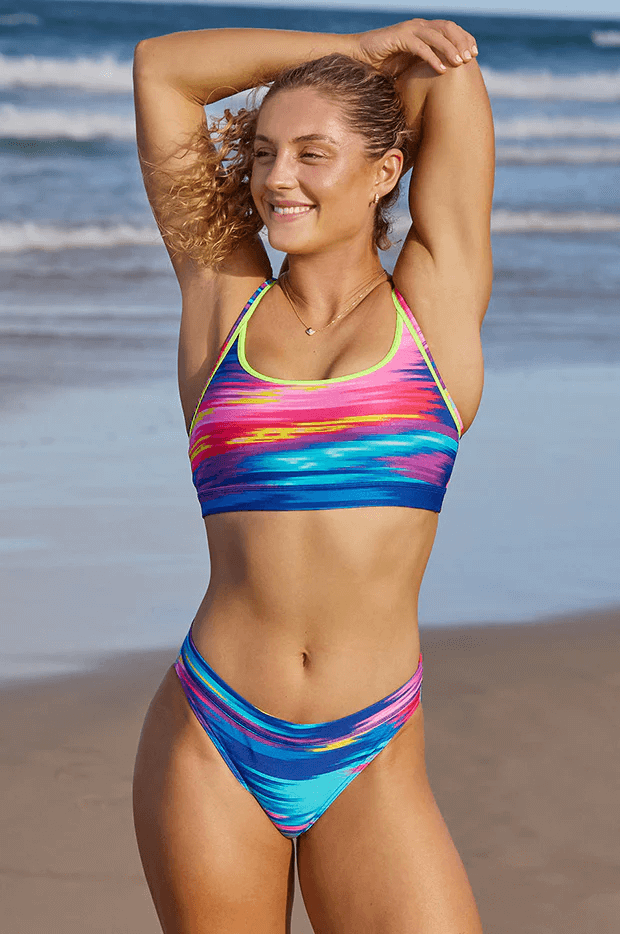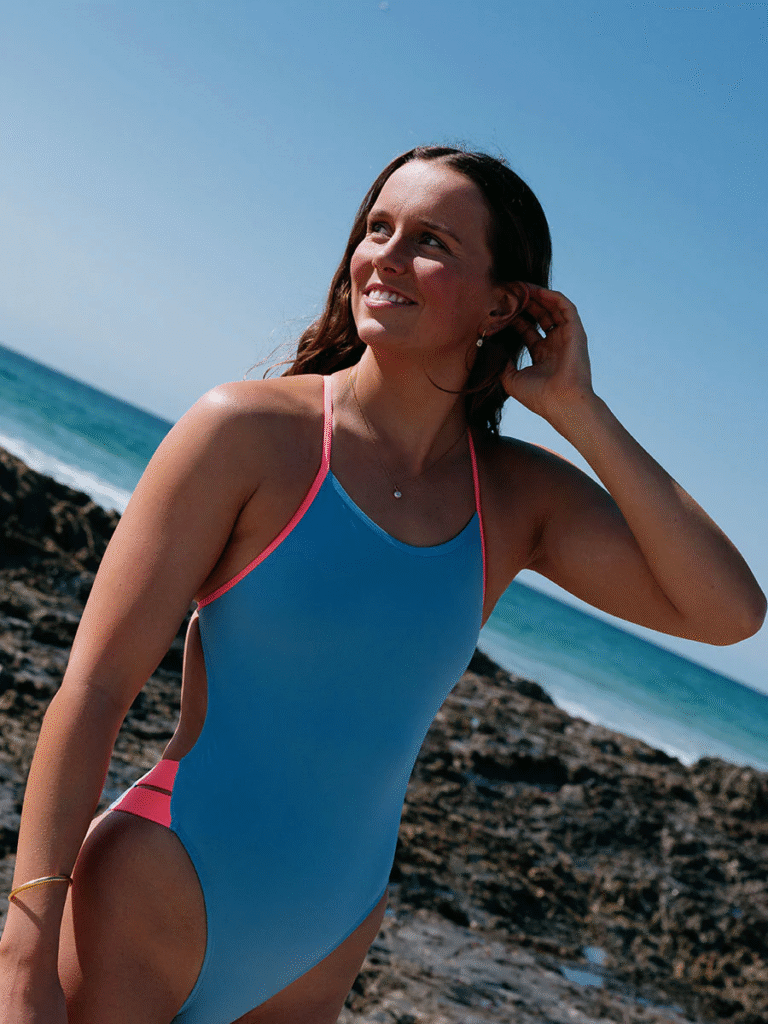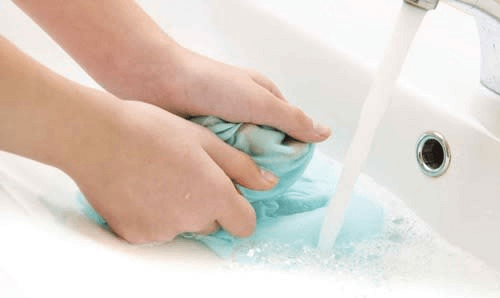Have you ever wondered why some swimsuits lose their shape or fade after only a few weeks of pool use? The culprit is chlorine — a disinfectant used in nearly every public pool.
While chlorine keeps water safe, it’s harsh on delicate fabrics. Over time, it breaks down elastic fibers, fades colors, and causes once-sleek swimwear to sag or lose its shine.
That’s where chlorine-resistant swimwear comes in. Designed with specialized fibers and advanced textile technology, these suits retain their shape, elasticity, and color even after hundreds of hours in chlorinated water.
In this guide, we’ll look at what chlorine-resistant swimwear is, what it does, the best fabrics to use, and how to care for it to extend the life of your swimwear.
What Is Chlorine Resistance in Swimwear?

Chlorine resistance refers to a fabric’s ability to withstand repeated exposure to chlorinated water without breaking down or losing elasticity. Chlorine is a strong oxidizing agent — it reacts with the chemical bonds in synthetic fibers, especially those made of elastane (spandex), which gives swimwear its stretch.
When ordinary spandex fibers are exposed to chlorine, the polymer chains begin to weaken. This leads to loss of stretch, thinning fabric, and dull colors. However, chlorine-resistant fabrics are engineered with modified polymers or alternative materials that resist oxidation and retain structural integrity for longer.
In essence, chlorine-resistant swimwear maintains its elasticity, color vibrancy, and strength far longer than standard nylon or spandex suits — making it the preferred choice for professional training gear and premium swimwear brands.
How Chlorine Affects Swimwear Fabrics
Chlorine’s job is to sanitize pools by breaking down organic matter — but that same chemical reaction can damage textile fibers. When swimwear is repeatedly exposed to chlorine, several things happen:
- Oxidation of fibers: Chlorine oxidizes the molecular structure of elastane, breaking its bonds and reducing elasticity.
- Color fading: Chlorine molecules strip dyes from the surface, especially in fabrics without color-stable coatings.
- Fabric stiffness: As elastane degrades, the material loses flexibility and feels rougher to the touch.
- Sagging and distortion: Once the fibers lose tension, the garment no longer fits as it originally did.
This degradation accelerates under heat or sunlight, meaning that outdoor pools or frequent washing can make the damage even worse.
Best Fabrics for Chlorine-Resistant Swimwear
Choosing the right fabric is the foundation of long-lasting, high-performance swimwear. Below are the most common materials and how they perform under chlorine exposure:
| Fabric Type | Chlorine Resistance | Stretch & Comfort | Typical Use |
|---|---|---|---|
| PBT Polyester | ★★★★★ Excellent | Moderate | Competitive and training suits |
| Chlorine-Resistant Spandex (CREORA® Highclo™, LYCRA® XTRA LIFE™) | ★★★★☆ High | Excellent | Fashion & performance swimwear |
| Recycled Polyester (rPET + PBT blend) | ★★★★☆ Good | Moderate | Sustainable swimwear collections |
| Nylon (Polyamide) | ★☆☆☆☆ Poor | Very soft & stretchy | Beachwear, short-term use |
Polyester (PBT): The Industry Standard
PBT is a type of polyester with high chlorine resistance, dimensional stability, and quick-drying properties.
Unlike nylon, it doesn’t absorb much water and retains its color even after hundreds of hours in the pool.
PBT also resists pilling and stretching, which is why it’s often used in competitive swimwear and resort uniforms.
Chlorine-Resistant Spandex
Conventional elastane breaks down quickly in chlorinated water, but innovations like CREORA® Highclo™ and LYCRA® XTRA LIFE™ have changed that.
These upgraded fibers are treated to resist chlorine and maintain elasticity up to ten times longer than ordinary spandex.
They combine comfort, stretch, and durability, making them ideal for premium fashion swimwear that needs both performance and fit.
Recycled Polyester Blends
Eco-friendly doesn’t have to mean fragile. Modern blends using recycled polyester (rPET) combined with PBT or Highclo elastane provide good chlorine resistance while reducing environmental impact.
These fabrics are OEKO-TEX and GRS certified, offering a responsible solution for brands focused on sustainability and longevity.
Nylon
Nylon is soft and flexible, giving swimwear a silky hand feel. However, it performs poorly against chlorine and loses shape quickly. It’s best reserved for casual beachwear or swimsuits meant for occasional use, not daily pool training.
Benefits of Chlorine-Resistant Swimwear
Investing in chlorine-resistant fabrics brings long-term advantages for both consumers and brands:
Protection: Chlorine-resistant fibers prevent chemical breakdown, keeping the garment intact longer.
Durability: Suits retain elasticity and shape after 200+ pool hours — compared to 30–40 hours for ordinary spandex.
Shape Retention: The fit remains snug and supportive without sagging.
Color Stability: PBT and treated spandex hold dyes better, reducing fading.
Brand Value: Consistent quality builds consumer trust and differentiates premium swimwear lines.
How to Know If a Swimsuit Is Chlorine-Resistant

Recognizing chlorine-resistant swimwear isn’t difficult once you know what to look for.
Here are some practical tips:
Check the fabric label:
Look for compositions like 100% polyester (PBT), polyester + PBT blend, or chlorine-resistant
Avoid suits labeled primarily as nylon + spandex, which degrade faster.
Identify fiber brands:
Fabrics featuring LYCRA® XTRA LIFE™, CREORA® Highclo™, or similar trademarks are proven to resist chlorine.
Ask manufacturers or suppliers
Reputable swimwear factories can provide test reports (e.g., chlorine immersion tests or colorfastness ratings) to prove durability.
Look for certifications:
OEKO-TEX® and GRS (Global Recycled Standard) indicate responsible sourcing and safety standards.
Manufacturing Tips for Chlorine-Resistant Swimwear
For swimwear brands, true chlorine resistance starts during fabric selection and production. Here’s how professional manufacturers ensure quality:
Choose High-Resistance Yarnsa.
Opt for PBT yarns or chlorine-treated elastane for maximum lifespan. Blending 70–80% PBT with 20–30% Highclo or XTRA LIFE spandex offers both durability and stretch.
Control Fabric Finishing
Heat-setting and proper dyeing techniques stabilize the fiber structure and prevent chlorine penetration.
Use Reinforced Stitching
Techniques like flatlock or zigzag stitching maintain stretchability and prevent seam damage under water pressure.
Add Double Lining
An inner lining adds support, protects outer fibers, and extends lifespan, especially in training swimwear.
Perform Quality Testinge
Regular chlorine immersion and elasticity recovery tests confirm real-world performance before bulk production.
Care Tips: Extend the Lifespan of Swimwear

Even the most durable fabrics last longer with proper care. Educating your customers on maintenance not only improves product satisfaction but also reflects brand professionalism.
After Each Swim:
Rinse swimwear immediately in cool, fresh water to remove chlorine and salt.
Washing:
Use mild detergent specifically for delicates. Avoid bleach and fabric softeners.
Drying:
Gently squeeze out excess water — never wring. Lay flat in shade to air dry. Avoid dryers or direct sunlight, which can weaken fibers.
Storage:
Store flat and dry. Avoid leaving wet swimwear in bags, which encourages bacterial growth and fiber decay.
Following these simple steps can double or even triple the lifespan of a high-quality swimsuit.
Summary
Chlorine resistance is more than a buzzword — it’s the science of swimwear longevity. The right combination of advanced fibers, thoughtful manufacturing, and proper care determines whether a swimsuit lasts weeks or years.
By choosing fabrics like PBT polyester or chlorine-resistant spandex, brands can deliver products that retain their beauty and performance through countless swims. For consumers, these materials mean better value, comfort, and reliability.
At JoyBikini, we specialize in producing high-performance, chlorine-resistant swimwear for global brands and start-ups alike. With premium fabrics, eco-friendly options, and strict quality control, we help our clients build collections that stand up to both chlorine and time.
Contact us today to create your custom chlorine-resistant swimwear line that blends durability, sustainability, and style.
FAQ
What makes a swimsuit chlorine resistant?
A swimsuit becomes chlorine resistant when made from fibers that can withstand chlorine exposure without breaking down. Materials like PBT polyester or chlorine-resistant elastane (e.g., LYCRA® XTRA LIFE™) maintain their stretch and color far longer than regular spandex blends.
Is polyester or nylon better for chlorine resistance?
Polyester, especially PBT, is far superior. Nylon absorbs more water and degrades quickly when exposed to chlorine. Polyester fibers are chemically stable, resist fading, and maintain their structure even after extensive use in pools.
How long does chlorine-resistant swimwear last?
While regular swimwear might lose shape within 30–40 hours of pool use, chlorine-resistant fabrics can last 200–300 hours or more with proper care. Lifespan depends on fabric quality, frequency of use, and maintenance habits.
Can sustainable fabrics also be chlorine resistant?
Yes. Many brands now use recycled polyester (rPET) blended with PBT or treated spandex to create eco-friendly and chlorine-resistant options. These fabrics are often OEKO-TEX and GRS certified, offering both performance and sustainability.
Is chlorine-resistant swimwear worth it?
Yes — chlorine-resistant swimwear is absolutely worth it, especially for anyone who swims regularly or manages swimwear brands catering to frequent pool use. While it can cost slightly more upfront, it lasts up to 5–10 times longer than regular nylon or spandex suits. These fabrics keep their shape, color, and elasticity, reducing the need for constant replacements.
